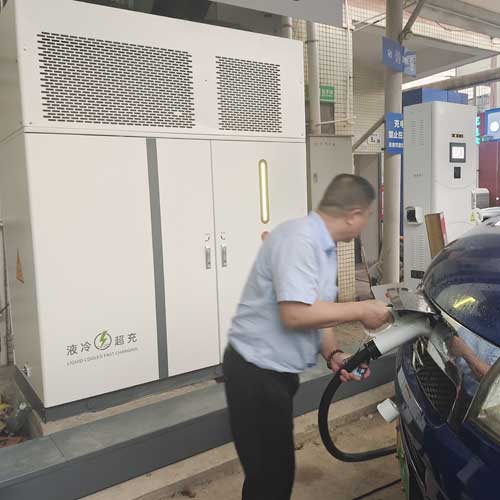-
 +86 18924678741
+86 18924678741 -
 sales@hjlcharger.com
sales@hjlcharger.com -
 Shenzhen City, Guangdong Province, China
Shenzhen City, Guangdong Province, China
Electric vehicle charging is an important link involving safety and battery life. The following is a detailed guide to electric vehicle charging:
1. Preparation before charging
Check the vehicle status: Make sure the electric vehicle is in a safe parking state, turn off all electrical devices such as radios, lights, etc. to reduce battery power consumption. At the same time, check the power display on the vehicle dashboard to understand the current battery status.
Check the charging interface: Carefully check whether the vehicle charging interface is damaged, foreign objects or water accumulation. If problems are found, they should be cleaned or repaired in time to ensure the normal use of the charging interface.
Choose a suitable charging location: Try to choose a dry, well-ventilated place away from flammable materials for charging. At the same time, ensure that the charging location has good grounding measures to ensure charging safety.

2. Choose a suitable charging method
Electric vehicles have a variety of charging methods, including home chargers, public chargers, and portable chargers. Choose a suitable charging method according to actual needs:
Home charger: If conditions permit, installing a home charger is a more convenient and economical option. Home chargers charge relatively quickly, and can be charged during the low-peak hours at night to save electricity costs.
Public charger: When you go out, you can choose a public charger for charging. Some DC fast chargers have high power and can quickly replenish power, which is suitable for situations where power replenishment is urgently needed. However, please note that frequent use of fast charging may cause certain damage to the battery, so it is recommended to use slow charging or mixed charging methods as much as possible.

Portable charger: Portable chargers are small in size, light in weight, and easy to carry. However, the charging speed is slow and is only suitable for emergency use.
III. Charging operation steps
Insert the charging gun: Insert the charging gun into the vehicle charging port, and make sure the charging gun is plugged in tightly to avoid poor contact.
Start the charging device: Depending on the charging method, start the charging device according to the operating instructions of the charging pile or charger. If you are using a public charger, you may need to scan a QR code or enter relevant information to charge.
Observe the charging indicator: The charging indicator can display the charging status, such as charging, charging completed, etc. If the charging indicator is found to be abnormal, stop charging in time and check the charging equipment and vehicle.
Check the battery temperature: During the charging process, the battery temperature will rise. If the battery temperature is too high, stop charging in time and take cooling measures.
IV. Charging precautions
Avoid overcharging: Overcharging will damage the battery and reduce the battery life. Generally speaking, charging should be stopped in time when the battery is fully charged. At the same time, the charging time should not exceed 12 hours, and it can usually be fully charged within 8-10 hours (including 1~2 hours of floating charge).
Pay attention to the charging environment: avoid charging in extremely high or low temperature environments to prevent battery overheating or performance degradation. In hot weather, you can turn off the vehicle for a while to wait for the battery temperature to drop before charging; in cold weather, it is recommended to charge immediately after stopping to improve charging efficiency.
Use appropriate equipment: Make sure to use chargers and charging guns that meet national standards, and avoid using unqualified or uncertified charging equipment to reduce safety hazards.
Comply with safety regulations: Keep dry during charging, avoid opening the door or starting or moving the vehicle. It is strictly forbidden to plug and unplug the charging plug with power on to prevent electric shock accidents.
Pay attention to personal safety: It is best not to stay in the car during charging, because the power battery is in a high current and high voltage working state at this time, which poses certain safety hazards.
V. Battery care and maintenance
Regularly check the battery status: Regularly check the battery capacity, voltage and other parameters as well as the connection and insulation of the battery components to help extend the battery life and ensure safety.
Avoid frequent fast charging: Although fast charging will not significantly shorten the battery life, in order to extend the battery life, it is recommended to use slow charging when conditions permit.
Choose a well-known brand charger: Using a brand charger from a well-known manufacturer can ensure a stable charging current that is more friendly to the battery.
In summary, the correct charging method and precautions are crucial to the performance and life of electric vehicles. Charging in accordance with the above guidelines can ensure the safety and effectiveness of the charging process while extending the battery life.
If you want to learn more about the "Electric Vehicle Charging Guide", you can consult us online or email (sales@hjlcharger.com).
The Spring Festival is approac
2025 POWER2DRIVE EUROPEPART OF THE SMARTER E EUROP...
The 2024 Asian Electric Vehicle Exhibition (EV Asi...
Against the backdrop of global energy transformati...
Learn about electric car batte
What should I do if the gun ca
Electric vehicle charging is a
Howmuchmoneycan10chargersearni
There are various types of ev
7.2kW EV Charger The Level 2 EV Charger
Commercial ev charging stations are char
As an solar charger for ev cars solution
Hongjiali New Energy is the leading prov
Whenever you need us, we're here for you. --- Contact us for all your support needs, from technology, general queries to information support, etc. Our hotline numbers and e-mail are open 24hx7d for your needs.

 +86 18924678741
+86 18924678741 sales@hjlcharger.com
sales@hjlcharger.com Shenzhen City, Guangdong Province, China
Shenzhen City, Guangdong Province, China